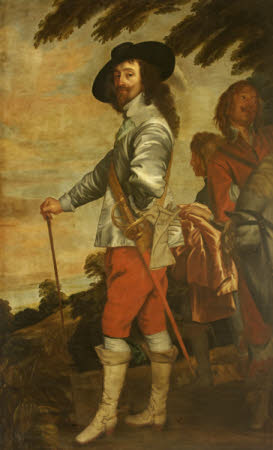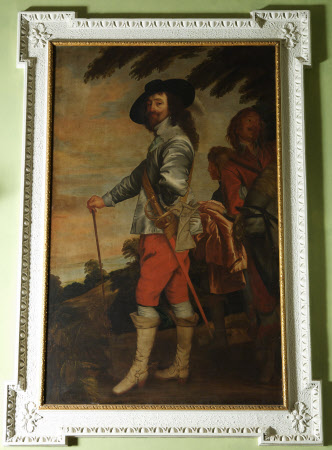King Charles I in the Hunting Field
after Sir Anthony Van Dyck (Antwerp 1599 - London 1641)
Category
Art / Oil paintings
Date
1700 - 1799
Materials
Oil on canvas
Measurements
2083 x 1295 mm (82 x 51 in)
Place of origin
England
Order this imageCollection
Lacock, Wiltshire
NT 996279
Caption
The King is shown in hunting attire, wearing a silver grey jacket with Garter ribbon, and scarlet breeches. Hunting was something the King enjoyed above all pleasures, and to which he devoted himself throughout the year. The scene is probably set in one of the parks in which the King hunted – it has been suggested that he is shown at Greenwich. Given the loyalty of the Talbots to the Stuarts, it seems possible that this partial copy was commissioned or acquired by Sir John Talbot (1630 – 1714). It is a copy of the left-hand side of the Louvre picture with the white horse on the right omitted.
Summary
Oil painting on canvas, King Charles I in the Hunting Field, after Sir Anthony Van Dyck (1599-1641). A partial copy of the original in the Louvre.
Full description
Oil painting on canvas, King Charles I in the Hunting Field, after Sir Anthony Van Dyck (1599-1641). This is a copy of the left-hand-side of the portrait in the Louvre (no.1236), with the body of the horse omitted. Other copies are at Euston Hall (omitting much of the horse and foreground), and Lamport Hall. The King is shown in hunting attire, wearing a silver grey jacket with Garter ribbon, and scarlet breeches. Hunting was something the King enjoyed above all pleasures, and to which he devoted himself throughout the year (see O. Millar in 'Van Dyck. A Complete Catalogue of the Paintings', New Haven & London, 2004, IV.50, pp.466-68). The scene is probably set in one of the parks in which the King hunted – given the suggestion of an estuary in the background, Greenwich was suggested by Millar in op.cit.supra.
Provenance
Given the loyalty of the Talbots to the Stuarts, it seems possible that this partial copy of – probably a copy of the portrait painted for Charles I, since that seems to have been sent abroad, and is next first recorded as a bequest from the comtesse de Verrue in 1736 – was commissioned or acquired by Sir John Talbot (1630 – 1714). But it might equally we have been acquired by John Ivory Talbot (c. 1691 – 1772), specifically to adorn the Dining Room. Given by Matilda Theresa Talbot (formerly Gilchrist-Clark) (1871 – 1958), who gave the Abbey, the village of Lacock and the rest of the estate to the National Trust in 1944, along with 96 of the family portraits and other pictures, in 1948.
Credit line
Lacock Abbey, The Talbot Collection (National Trust)
Makers and roles
after Sir Anthony Van Dyck (Antwerp 1599 - London 1641), artist

